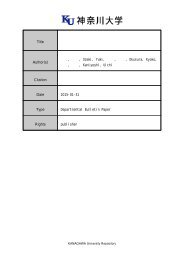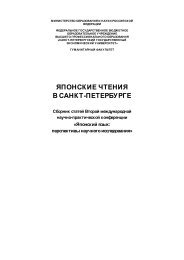to Learners with Special Educational Needs
e-textbook SEN
e-textbook SEN
Create successful ePaper yourself
Turn your PDF publications into a flip-book with our unique Google optimized e-Paper software.
Pokrivčáková, S. et al. (2015). Teaching Foreign Languages <strong>to</strong> <strong>Learners</strong> <strong>with</strong> <strong>Special</strong> <strong>Educational</strong> <strong>Needs</strong>:<br />
e-textbook for foreign language teachers. Nitra: Constantine the Philosopher University. 128 p.<br />
ISBN 978-80-558-0941-0<br />
3. Give yourself a reward after accomplishing the task.<br />
4. If you are anxious when speaking in front of people, imagine that those are you friends and it<br />
is an informal chat. (Many students tend <strong>to</strong> imagine cabbage heads or different objects<br />
instead of the people in the audience.)<br />
5. Write down your feelings or let your teacher know about how you feel.<br />
Moreover, relaxation techniques are becoming more and more discussed nowadays. Deep<br />
breathing, meditation or getting moving are some of the examples. Robinson et al. (2015)<br />
suggest progressive muscle relaxation, visualization meditation, yoga or tai chi as further<br />
techniques how <strong>to</strong> overcome stress and alleviate anxiety from the longitudinal point of view.<br />
The above mentioned recommendations and strategies may be very helpful in the classroom<br />
but it is important <strong>to</strong> bear in mind that all the students are different in their feelings and<br />
manifestation and each student requires different approach from the teacher.<br />
Conclusion<br />
It is human and natural <strong>to</strong> feel stress or anxiety in certain situations. However, it is important<br />
<strong>to</strong> be able <strong>to</strong> cope <strong>with</strong> the negative feelings so that they do not affect one´s learning and<br />
performance.<br />
According <strong>to</strong> the above mentioned researches, anxiety, which is present among the students<br />
of FL, negatively influences students´ acquisition of FL and further performance. Although<br />
anxiety is an abstract term, it can be observed by students in a form of blushing, rubbing the<br />
palms, perspiration, staggered voice, either <strong>to</strong>o slow or <strong>to</strong>o fast speech, poor performance,<br />
forgetfulness etc. Students are very individual and therefore, the signs may differ in their<br />
manifestation or severity. That is, some learners may completely forget what they have learnt<br />
and be unable <strong>to</strong> perform in any way (oral or written) or some learners need only small hint,<br />
help or motivation <strong>to</strong> be able <strong>to</strong> perform <strong>with</strong> imperceptible signs of anxiety.<br />
There are many fac<strong>to</strong>rs such as classroom environment and its atmosphere, learners´ selfesteem,<br />
the evaluation coming from the classmates, etc. that are the source of anxiety. Students<br />
themselves declared the strictness and formality of the classroom as the major fac<strong>to</strong>r of FLA.<br />
Moreover, the teacher´s attitudes or favouritism cause FLA as well. Therefore, the role of the<br />
teacher is even more important, because the teacher is the person in the classroom who can<br />
regulate the atmosphere, search for the signs of anxiety and help students <strong>to</strong> overcome it.<br />
Although the results of the researches were similar in demonstrating the presence of anxiety<br />
in the classrooms and its negative effect on FL, more studies need <strong>to</strong> be done in this area <strong>to</strong><br />
investigate the interplay of various contributing variables as the exact nature of this relationship<br />
is still blurry and may be influenced by various concomitant fac<strong>to</strong>rs.<br />
Acknowledgement<br />
The chapter presents the partial results of the KEGA 036UKF-4/2013 project funded by the<br />
Ministry of Education, Science, Research and Sport of the Slovak Republic.<br />
References<br />
AIDA, Y. (1994). Examination of Horwitz, Horwitz and Cope’s construct of foreign language<br />
anxiety: The case of students of Japanese. The Modern Language Journal, 78, 155-167.<br />
AL-SARAJ T. M. (2011). Foreign language anxiety: What is it? Paper presented at 4th Bloomsbury<br />
Student Conference in Applied Linguistics. Birkbeck College, University of London, the UK. 2-3.<br />
Available at:<br />
https://scholar.google.com/citations?view_op=view_citation&hl=en&user=02s0WsMAAAAJ&<br />
citation_for_view=02s0WsMAAAAJ:d1gkVwhDpl0C.<br />
ARGAMAN, O. & ABU-RABIA, S. (2002). The influence of language anxiety on English reading and<br />
writing tasks among native Hebrew speakers. Language, Culture and Curriculum, 15, 143-160.<br />
97






